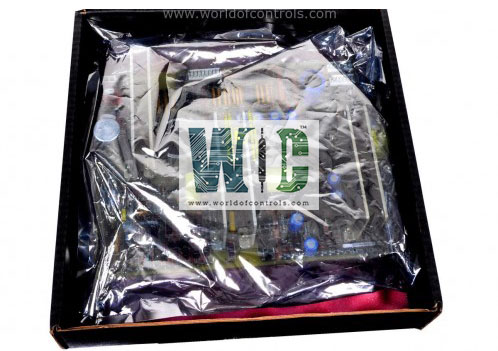
World Of Controls understands the criticality of your requirement and works towards reducing the lead time as much as possible.
DS3800SVRA - Static Voltage Regulator Board is available in stock which ships the same day.
DS3800SVRA - Static Voltage Regulator Board comes in UNUSED as well as REBUILT condition.
To avail our best deals for DS3800SVRA - Static Voltage Regulator Board, contact us and we will get back to you within 24 hours.
SPECIFICATIONS:
Part Number: DS3800SVRA
Manufacturer: General Electric
Series: Mark IV
Product Type: Static Voltage Regulator Board
AC Voltage Adjustment: 198–242 V
Power Consumption: 150–250 W
Output Voltage: +5 V DC
AC Frequency Range: 50–360 Hz
DC Voltage Adjustment: 10–110 V DC
Power Requirements: +5 V dc, 8 A
Number of relay channels: 16
Load Capacity: Up to 10 kVA
Operating Temperature: 0°C to +60°C
Size: 15.9 cm high x 17.8 cm
Weight: 0.9kg
Repair: 3-7 Days
Availability: In Stock
Country of Origin: United States
FUNCTIONAL DESCRIPTION:
DS3800SVRA is a Static Voltage Regulator Board manufactured and designed by General Electric as part of the Mark IV Series used in GE Speedtronic Gas Turbine Control Systems. The AC regulator controls the generator’s AC voltage, while the DC regulator manages the generator’s DC field voltage. Both function as pulse-width modulators (PWM) that adjust the SVR output voltage. The DC regulator regulates the field current of the synchronous machine by controlling the SVR output, and the AC regulator maintains the AC voltage at the machine terminals. Operating independently, either regulator continues to function if the other fails, with selection between AC or DC control made by the operator or protective relays. The AC regulator offers an adjustment range of 85% to 110% of the rated generator voltage via a 120-volt PT circuit, while the DC regulator allows adjustment from 10 V DC to 110 V DC.
FAULT CURRENT SUPPORT:
When generator fault current support is needed, excitation is automatically maintained from a DC source, such as a station battery (see Figure 1). A rectifier between the DC bus and the DC source is normally held off by the higher AC source voltage. If the AC voltage drops, as during a fault, the DC source takes over to sustain excitation during the interruption. These interruptions are rare and typically last only 5 to 10 cycles, imposing minimal load on the battery. An auxiliary bus AC source should not be relied upon for fault support, as such sources generally follow generator terminal voltage dips. Fault current support is unnecessary when the AC power source is a PMG.
PROTECTIVE FUNCTION:
The SVR includes a volts-per-hertz (V/Hz) limit to protect the synchronous machine. If the machine’s V/Hz drops below a pre-set value, the volts-per-hertz function causes the AC regulator to reduce field current, ensuring the V/Hz limit is not exceeded. This function is inactive under DC regulator control. Under AC regulator operation, the SVR maintains generator terminal voltage up to a pre-set field current limit and will not increase field current beyond this limit in steady-state conditions. Similarly, in DC regulator control, the operator cannot raise the field current above the instantaneous field current limit.
CONFIGURATION:
This regulator is compatible with exciters with or without a PMG, including DC exciters and brushless types. The AC (automatic) regulator controls generator terminal voltage, while the DC (manual) regulator controls exciter field voltage. Both regulators feature fully redundant circuits and power transistors. Bumpless transfer between AC and DC regulators is achieved using a transfer voltmeter (TVM), which ensures that when the TVM reads zero, switching regulators does not affect excitation or generator terminal voltage. The AC power source can be a PMG, auxiliary bus, or generator terminals at frequencies from 50 to 360 Hz, with three-phase preferred but single-phase acceptable. The regulator supports “black start” by drawing AC power from generator terminals via a potential transformer (PPT) and flashing from the station battery; a PMG source also enables black start. Fault current support is provided by applying a DC source to maintain excitation during AC power interruptions, with only 125 V sources acceptable. The regulator is self-powered from the AC source, with DC required only for flashing, fault current support, or customized relaying applications.
WOC offers the largest stock of replacement parts for GE Speedtronic Gas Turbine Control Systems, including unused, rebuilt, and refurbished modules, all backed by a warranty. We also provide expert repair services for faulty boards, helping extend equipment life and minimize downtime. Our team of experienced engineers is available 24/7 to support your OEM and automation needs, providing technical guidance, pricing, and availability information. Contact WOC by phone or email for fast, reliable solutions that keep your turbine control systems running at peak performance.
What types of exciters are compatible with this SVR?
The SVR is compatible with DC exciters, brushless exciters, and exciters with or without a PMG. It can operate in both AC and DC regulation modes. This makes it suitable for a wide range of generator configurations.
What is the difference between AC and DC regulator control?
The AC regulator controls generator terminal voltage automatically, while the DC regulator controls the exciter field voltage manually. Both operate independently, ensuring continuous operation if one fails. The operator can select the preferred control mode.
How does bumpless transfer between AC and DC regulators work?
Bumpless transfer is achieved using a Transfer Voltmeter (TVM). When the TVM reads zero, switching between AC and DC regulators does not affect excitation or terminal voltage. This ensures smooth operation without voltage dips or spikes.
What AC power sources can be used for the regulator?
The regulator can draw AC power from a PMG, an auxiliary bus, or directly from generator terminals. It operates across a frequency range of 50–360 Hz. While three-phase sources are preferred, single-phase sources are also supported.